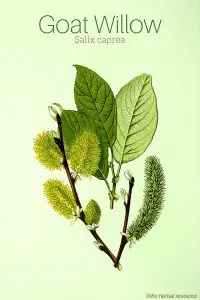The fact that the bark of goat willow has analgesic and antipyretic properties, was already known by the philosophers of ancient Greece Hippocrates and Theophrastus.
In medieval times in many parts of Europe, the medicinal properties of the bark were known and the bark was commonly chewed on in order to relieve pain associated with a headache and toothache.
Furthermore, the bark was used traditionally as an astringing agent, to halt bleeding, and as a remedy for diarrhea.
Externally, extracts of the bark were used traditionally to clean wounds and as a remedy for minor skin inflammations, injuries, and aches. Once the bark was also added to vinegar and used as a treatment for warts.
Natural Source of Salicylic Acid
The plant genus Salix is large and all species in the genus contain salicylates (e.g. salicortin, salicin and tremulacin) to a greater or lesser extent.
It is primarily white willow (Salix alba) and purple osier willow (Salix purpurea) that have been used to extract salicylic acid. Salicylic acid was first isolated from totally unrelated species meadowsweet (Filipendula ulmaria).
Salicylic acid is the precursor of acetylsalicylic acid, a synthetic substance similar to the salicylic acid recovered from the bark of goat willow and other plants, and it was first introduced by the German company Bayer in 1899.
The name Aspirin has become the generic name for acetylsalicylic acid medicines and is one of the most widely used medicinal substances in the world. Acetylsalicylic acid is commonly used for its fever-reducing, antirheumatic and analgesic properties, and is the active substance in many well-known medications such as Albyl-E, Dispril, and Globoid.
Due to the fact that goat willow and other willows are a natural source of salicylic acid, the bark of these plants can be a useful remedy for arthritis and rheumatic ailments, especially when the back, knees, and hips are affected.
In combination with other herbs, goat willow bark may be helpful in relieving inflammation and swelling and provide greater mobility in painful and rigid joints.
Preparations containing extract of the bark can also be used as a remedy for high fever, the common cold, minor infections, mild headaches and pain caused by inflammation.
The bark also has a high content of tannins, and a decoction of the bark can be used as a gargle in the treatment for a sore throat, and a tea made from the bark can be used as a remedy for heartburn, minor stomach ailment, and food poisoning. The herb may also reduce night sweats and hot flushes associated with menopause.
The advantage of using goat willow bark or meadowsweet instead of the synthetic drug Aspirin is that the herbs do not thin the blood or irritate the stomach, which are common side effects of Aspirin.
The analgesic effect of willow bark is slower but longer lasting than the one achieved with Aspirin. The downside of using goat willow is that its medicinal effect can be somewhat unpredictable and depends largely on the presence of enough friendly gut flora to convert the bark’s active components to the desired pain-relieving substances.
[Read more about Goat Willow…]

Leave a Reply